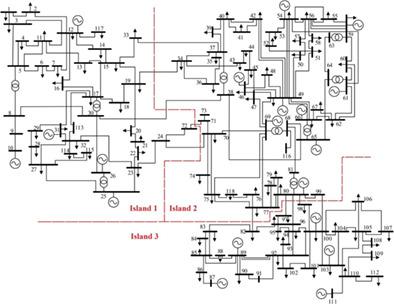当前位置:
X-MOL 学术
›
Int. Trans. Electr. Energy Syst.
›
论文详情
Our official English website, www.x-mol.net, welcomes your
feedback! (Note: you will need to create a separate account there.)
Incorporating energy storage and demand response into intentional controlled islanding using time decomposition
International Transactions on Electrical Energy Systems ( IF 1.9 ) Pub Date : 2020-08-06 , DOI: 10.1002/2050-7038.12553 Mohammad Ghamsari‐Yazdel 1 , Hamid Reza Najafi 1 , Nima Amjady 2
International Transactions on Electrical Energy Systems ( IF 1.9 ) Pub Date : 2020-08-06 , DOI: 10.1002/2050-7038.12553 Mohammad Ghamsari‐Yazdel 1 , Hamid Reza Najafi 1 , Nima Amjady 2
Affiliation

|
To improve electrical energy system resilience under catastrophic events, an efficient intentional controlled islanding (ICI) model is proposed in this article. The proposed remedial action relies on a new mixed integer linear programming (MILP) model which aims at minimizing the overall energy curtailment, power flow disruption, and generation and demand re‐dispatches through a cost‐based objective function. Another innovative characteristic of this model is demand response (DR) inclusion in the proposed ICI. To improve the balance between demand and supply of electricity, DR can be employed as an effective strategy in the ICI problem. In addition, another main original feature of the proposed model is considering energy storage units (ESUs) in each resulted island after the splitting process. To provide enough time for the system operator to re‐dispatch the islands and to improve frequency stability of islands, a charging/discharging scheme is proposed for ESUs during ICI. Moreover, a new time decomposition is proposed to accurately model the fast and slow corrective actions considering their interactions. Using this time decomposition, energy curtailments, considering their period durations, are treated as decision variables in the ICI problem to minimize involuntary load shedding as the most expensive corrective action. The results of scrutinizing the proposed ICI framework on the IEEE 118‐bus test system illustrate its performance. In addition, the results of the proposed ICI approach are compared with the results of other ICI models to illustrate the effectiveness of the new features of the proposed approach.
中文翻译:

使用时间分解将能量存储和需求响应纳入故意控制的孤岛中
为了提高灾难性事件下的电能系统弹性,本文提出了一种有效的有意控制孤岛(ICI)模型。拟议的补救措施依赖于新的混合整数线性规划(MILP)模型,该模型旨在通过基于成本的目标函数来最大程度地减少总体能源消耗,潮流中断以及发电和需求重新分配。该模型的另一个创新特征是在建议的ICI中包含需求响应(DR)。为了改善电力供需之间的平衡,可以将DR用作ICI问题中的有效策略。此外,该模型的另一个主要原始特征是考虑了分割过程后每个结果岛中的能量存储单元(ESU)。为了给系统操作员提供足够的时间来重新分配孤岛并提高孤岛的频率稳定性,在ICI期间为ESU提出了一种充电/放电方案。此外,提出了一种新的时间分解方法,以考虑快速和慢速纠正措施之间的相互作用,从而准确地对其建模。使用此时间分解,将考虑到其持续时间的能量缩减视为ICI问题中的决策变量,以最大程度地减少作为最昂贵的纠正措施的非自愿减载。在IEEE 118总线测试系统上仔细审查提议的ICI框架的结果说明了其性能。此外,将提出的ICI方法的结果与其他ICI模型的结果进行比较,以说明提出的方法的新功能的有效性。
更新日期:2020-10-11
中文翻译:

使用时间分解将能量存储和需求响应纳入故意控制的孤岛中
为了提高灾难性事件下的电能系统弹性,本文提出了一种有效的有意控制孤岛(ICI)模型。拟议的补救措施依赖于新的混合整数线性规划(MILP)模型,该模型旨在通过基于成本的目标函数来最大程度地减少总体能源消耗,潮流中断以及发电和需求重新分配。该模型的另一个创新特征是在建议的ICI中包含需求响应(DR)。为了改善电力供需之间的平衡,可以将DR用作ICI问题中的有效策略。此外,该模型的另一个主要原始特征是考虑了分割过程后每个结果岛中的能量存储单元(ESU)。为了给系统操作员提供足够的时间来重新分配孤岛并提高孤岛的频率稳定性,在ICI期间为ESU提出了一种充电/放电方案。此外,提出了一种新的时间分解方法,以考虑快速和慢速纠正措施之间的相互作用,从而准确地对其建模。使用此时间分解,将考虑到其持续时间的能量缩减视为ICI问题中的决策变量,以最大程度地减少作为最昂贵的纠正措施的非自愿减载。在IEEE 118总线测试系统上仔细审查提议的ICI框架的结果说明了其性能。此外,将提出的ICI方法的结果与其他ICI模型的结果进行比较,以说明提出的方法的新功能的有效性。











































 京公网安备 11010802027423号
京公网安备 11010802027423号